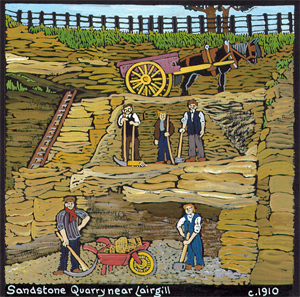|
Thanks to the quirks of local
geology, Bentham is blessed with many sorts of stone, and over
the centuries a use has been found for all of them. The limestone to our North is not top quality for building
or carving - too many fossils - but many sturdy farmhouses and
countless miles of dry stone walls are built from it nonetheless.
Just as usefully, when burnt and slaked, it becomes lime, an
alkali which sweetens acid peaty soils to grow better grass,
and makes lime mortar, a traditional building material. Nowadays
much is crushed for
The limestone to our North is not top quality for building
or carving - too many fossils - but many sturdy farmhouses and
countless miles of dry stone walls are built from it nonetheless.
Just as usefully, when burnt and slaked, it becomes lime, an
alkali which sweetens acid peaty soils to grow better grass,
and makes lime mortar, a traditional building material. Nowadays
much is crushed for
road-chippings, exported nationwide.
The bizarre water-carved stone
creatures
decorating garden wall tops around Bentham
are also limestone.
Schoolchildren used to "rescue" these from the vast
limestone pavements around
Ingleborough and sell them for pocket-money.
This activity is now illegal - the stones are a protected
species!
|
Most of Bentham's older buildings
are sandstone, probably originating from the old quarry near
Lairgill. Over short distances,transport of heavy
blocks by horse & cart was no problem. Just across the valley
from here, a larger quarry near Grey Stone Gill also yielded
sandstone, possibly for export, as the railway passed close by.
Ancient coalpits nearby at Ridding Lane suggest this quarry may
also have had coal seams, handy for topping up the steam trains
as well as
domesic use

A well-built wall will last for
centuries
Millstone grit made millstones, of
course, for the mills; and querns, the manual version. Whernside,
Quernmore and Ingleborough, whose "flat cap" is millstone
grit, are notable local outcrops. These millstones, whether powered
by water, horse, wind, or human hand, were for millennia the
only way to grind grains to make them edible as flour. Without
a quern, you might easily have starved. Lumps of this stone,
which is rough and incredibly tough, were a valuable trading
commodity from ancient times till recently.

Turning the quern with one hand,
while pouring in grain with the other.
|
Dry stone walls are an ancient
form of livestock enclosure that works equally well today. They
are also a handy way to tidy up stony fields! The basic local
technique is a double-skinned structure with "throughs",
a rubble filling, and heavy topstones to
lock it all together. You can see where an old wall has been
repaired as every waller has a distinctive style. This artistry
is also expressed in the great variety and ingenuity of the stiles
built in to walls. These often incorporate curious stones, or
cast-iron pots (upside-down!) which are old kilns for making
gunpowder charcoal, like the one nearest the church.

Datestones on buildings also reveal the individuality of these
bygone craftsmen - our ancestors.
*********************
The ice-age glaciers brought gravel-banks
and boulders, large and small, including "Erratics"
such as the Big Stone, which were left behind when the glaciers
melted. The other three Great Stones of Fourstones
are missing - a tradition says they were broken up to make whetstones
for scythes, but that would have been enough whetstones to keep
all England mowing for centuries!
|